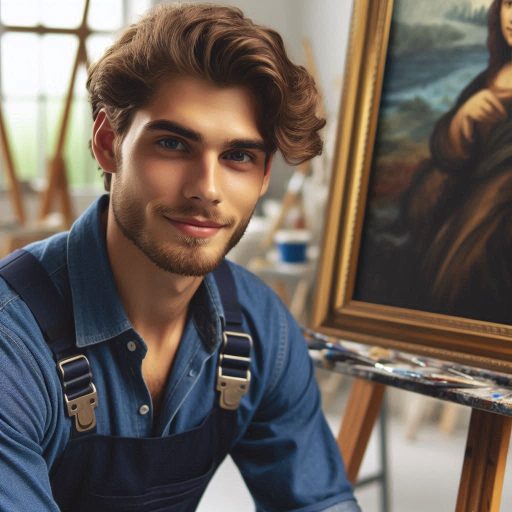Introduction
Art conservation is a crucial field dedicated to preserving and protecting cultural artifacts for future generations.
However, misconceptions about art conservation abound, often leading to misunderstandings about its goals and methods.
This post aims to clarify these misconceptions by defining art conservation and highlighting its significance in safeguarding cultural heritage.
Art conservation involves a range of activities designed to stabilize and maintain artworks.
It encompasses the examination, documentation, treatment, and preventive care of art objects.
Conservators use scientific methods to analyze materials and techniques, ensuring that interventions do not alter the original intent of the artwork.
Unlike restoration, which may aim to recreate missing elements, conservation focuses on preserving the existing integrity of the piece.
Conservators often work closely with historians and scientists to understand the best methods for care.
Their goal is to slow down deterioration, allowing artworks to be enjoyed and studied by future generations.
This field requires a deep understanding of both art history and material science.
Art conservation plays a vital role in preserving cultural heritage.
It ensures that artworks and artifacts, which embody historical, cultural, and artistic values, remain intact for future study and appreciation.
By preserving these items, we maintain a tangible connection to the past, enriching our understanding of different cultures and historical periods.
Effective conservation protects against the ravages of time, environmental damage, and human interference.
It enables future generations to access and learn from these cultural treasures, fostering a continued appreciation of human creativity and history.
Without proper conservation, many invaluable artifacts might be lost or irreparably damaged, leading to a significant cultural and historical loss.
In summary, art conservation is essential for maintaining the integrity of cultural heritage.
It ensures that our artistic and historical treasures endure for future generations to study and enjoy.
Misconception 1: Art conservation is only about cleaning artwork
Many people believe art conservation is only about cleaning artwork.
There are various aspects to art conservation beyond just cleaning.
Transform Your Career Today
Unlock a personalized career strategy that drives real results. Get tailored advice and a roadmap designed just for you.
Start NowThese include stabilization, restoration, and documentation.
Stabilization
Stabilization involves ensuring that the artwork is structurally sound and preventing further damage.
This can include consolidating flaking paint, repairing tears or cracks, and addressing any issues that may compromise the stability of the artwork.
Restoration
Restoration goes beyond cleaning to repair and rebuild the artwork to its original state.
This can involve inpainting areas of loss, recreating missing parts, or addressing previous restoration attempts that may have compromised the artwork.
Documentation
Documentation is a crucial aspect of art conservation, as it involves recording the condition of the artwork before and after treatment.
This helps in tracking changes over time and ensuring that future conservators have a record of the work that has been done.
Conservation techniques can vary depending on the specific needs of the artwork. Some examples of techniques beyond cleaning include:
- Chemical stabilization of unstable paint layers.
- Humidification and flattening of wrinkled or distorted paper.
- Consolidation of flaking or powdery surfaces.
- Removal of non-original varnishes or overpaint.
- Reintegration of paint losses using reversible materials.
By understanding the various aspects of art conservation, we can appreciate the complexity and skill involved in preserving our cultural heritage for future generations.
Read: Impact of Technology on Art Conservation
Misconception 2: Anyone can do art conservation
Art conservation is often misunderstood as a task anyone can handle.
In reality, it requires specialized training and extensive knowledge.
Here’s why this misconception doesn’t hold true.
The specialized training and knowledge required for art conservation
Art conservation isn’t just about cleaning a painting or repairing a sculpture.
It involves understanding complex materials, techniques, and historical contexts.
Conservators need to grasp the chemistry of materials and the history of art movements.
They must also be skilled in various restoration techniques tailored to different media.
Conservators study for years to gain this expertise.
They usually hold advanced degrees in art conservation or related fields.
Showcase Your Business Today
Reach thousands of readers actively exploring professional services. Publish your business profile and grow your audience now.
Publish NowTheir training includes in-depth courses on material science, restoration techniques, and ethical considerations.
This education helps them make informed decisions about how to preserve artworks without causing further damage.
Professional organizations and certifications in the field
Professional organizations play a crucial role in maintaining high standards in art conservation.
Institutions like the American Institute for Conservation (AIC) offer certifications and resources for conservators.
These organizations ensure that professionals adhere to rigorous standards and stay updated on best practices.
Certification from such bodies demonstrates a conservator’s competence and commitment to the field.
Moreover, conservators often collaborate with scientists and historians to solve complex conservation issues.
This interdisciplinary approach further underscores the specialized nature of the profession.
It’s not just about having a passion for art; it’s about possessing the technical skills and knowledge to protect cultural heritage effectively.
In essence, art conservation is a highly specialized field.
It demands rigorous training and adherence to professional standards.
Understanding this can help debunk the myth that anyone can take on this critical task.
Read: Art Conservation Techniques and Best Practices

Misconception 3: Art Conservation Removes All Signs of Age from Artwork
A common misconception is that art conservation aims to erase all signs of age from artwork.
In reality, art conservation focuses on preserving both the physical integrity and historical context of the piece.
Ethical Considerations in Art Conservation
Art conservation is guided by ethical considerations that prioritize preserving the artist’s original intent and the artwork’s historical significance.
Conservators aim to maintain the authenticity of the piece, ensuring that any interventions respect the artist’s vision.
This means that repairs and restorations are performed in a way that does not obscure the original work.
Conservators document their processes thoroughly, allowing future generations to understand the changes made.
This respect for the artist’s intent and historical context is crucial for maintaining the artwork’s cultural and historical value.
Balancing Restoration and Preservation
In art conservation, balancing restoration with preservation is essential.
Restoration involves repairing damage and stabilizing the artwork to prevent further deterioration.
However, this should not be confused with completely removing signs of age.
Preservation focuses on maintaining the artwork in its current state, including visible signs of aging, as these contribute to its historical narrative.
Conservators use minimal intervention techniques, only addressing issues that could lead to further damage.
This approach ensures that the artwork remains as true to its original state as possible while being protected for future generations.
Art conservation does not aim to erase history but to balance the preservation of the artwork’s integrity with respectful restoration.
By maintaining visible signs of age, conservators honor the artwork’s journey and significance.
Read: Top Museums Hiring Art Conservators/Restorers
Misconception 4: Art conservation is a one-time process
Many people believe art conservation is a one-time fix.
This misconception undermines the reality of preserving valuable artworks.
Conservation is not just a single event but an ongoing process.
Artworks, especially fragile or deteriorating ones, require continuous attention.
The ongoing nature of art conservation, especially for fragile or deteriorating artworks
Art conservation involves more than initial treatments.
It demands regular upkeep to ensure lasting protection.
For example, paintings on canvas or wood may need frequent inspections.
Changes in environmental conditions can cause new issues that must be addressed.
Regular maintenance is crucial to prevent further damage.
This includes monitoring factors like humidity, temperature, and light exposure.
Conservators often perform periodic checks to assess the condition of the artwork.
Showcase Your Business Today
Reach thousands of readers actively exploring professional services. Publish your business profile and grow your audience now.
Publish NowThey make necessary adjustments to the conservation measures based on these assessments.
Artworks are dynamic and may face new challenges over time.
For instance, paper-based materials can become more brittle or discolored.
Each of these issues requires specific treatments to preserve the integrity of the artwork.
The importance of regular maintenance and monitoring of artwork
By scheduling regular maintenance, conservators can detect and address issues early.
This proactive approach helps prevent minor problems from becoming major ones.
It also extends the life of the artwork, ensuring its preservation for future generations.
In a nutshell, art conservation is an ongoing process, not a one-time fix.
The fragile nature of artworks demands continuous care and regular monitoring.
Proper maintenance ensures that these valuable pieces remain preserved and appreciated over time.
Read: How to Start a Career in Art Conservation
Misconception 5: Art conservation is prohibitively expensive
Many believe art conservation is prohibitively expensive.
This misconception often deters individuals and institutions from pursuing essential preservation work.
However, understanding the true costs and available funding options can change this perspective.
The cost of art conservation and factors that influence pricing
The cost of art conservation varies widely.
Factors influencing pricing include the type of artwork, its condition, and the complexity of the required treatment.
For instance, restoring a large, historically significant painting may be more costly than a small, contemporary piece.
Additionally, the level of damage and the techniques needed for repair significantly impact the overall cost.
Professionals assess each piece individually to provide an accurate estimate.
While initial costs may seem high, conservation prevents further deterioration, ultimately saving money in the long run.
Regular maintenance and timely interventions can prevent more expensive repairs down the line.
Information on funding sources for art conservation projects
Funding for art conservation is more accessible than many think.
Several sources can help cover costs, making preservation projects more feasible.
Museums and cultural institutions often seek grants from government bodies and private foundations dedicated to preserving cultural heritage.
Examples include the National Endowment for the Arts and the Getty Foundation.
Crowdfunding is another option for smaller projects.
Platforms like Kickstarter or GoFundMe can rally community support and raise necessary funds.
Additionally, some organizations offer sponsorship opportunities for conservation projects, allowing donors to contribute to specific initiatives.
Basically, while art conservation can involve significant expenses, various factors influence the costs, and multiple funding sources are available.
Understanding these aspects can help dispel the myth that art conservation is prohibitively expensive and encourage more efforts to preserve our cultural heritage.
Misconception 6: Art conservation results in a “perfect” restoration
One common misconception about art conservation is that the end result of the process is a flawless and “perfect” restoration.
However, this is far from the truth. In reality, art conservation aims to preserve the original integrity of the artwork while addressing any damage or deterioration it may have incurred over time.
The goal is not to make it look brand new, but rather to ensure that it can be enjoyed for generations to come.
The concept of “reversibility” in art conservation and the potential for future interventions
A fundamental principle in art conservation is the concept of reversibility.
This means that any interventions made during the conservation process should be able to be undone without causing further harm to the artwork.
By using reversible materials and techniques, conservators are able to adapt to new technologies and methodologies that may become available in the future.
This ensures that the artwork remains flexible and can be re-evaluated and treated as needed.
The value of patina and signs of age in artwork
Another important aspect of art conservation is recognizing the value of patina and signs of age in artwork.
These elements contribute to the history and character of a piece, providing a glimpse into its past and the hands it has passed through.
While some may see signs of wear as flaws that need to be corrected, conservators understand that they are an integral part of the piece’s story.
Showcase Your Business Today
Reach thousands of readers actively exploring professional services. Publish your business profile and grow your audience now.
Publish NowPreserving these imperfections can actually enhance the beauty and authenticity of the artwork.
All in all, art conservation is a delicate balance between preserving the past and preparing for the future.
By embracing the concept of reversibility and appreciating the value of patina, conservators are able to safeguard the integrity of artwork while respecting its history and unique characteristics.
Understanding these principles can help debunk common misconceptions about art conservation and highlight the importance of ethical and thoughtful preservation practices.
Conclusion
It is important to dispel common misconceptions about art conservation.
It is crucial to understand that art conservation is a specialized field that requires expertise.
Many people believe that DIY methods are sufficient for preserving and restoring artwork, but this is not the case.
Another common misconception is that art conservation is only necessary for valuable or antique pieces, but all artwork can benefit from proper care.
It is also important to recognize that professional conservators have the knowledge and skills to address a wide range of issues with artwork.
If you have artwork that needs attention, it is best to seek out professional conservators who can provide expert care.
By working with a professional conservator, you can ensure that your artwork receives the proper treatment it deserves.
Don’t let misconceptions about art conservation prevent you from preserving and enjoying your valuable pieces. Trust the experts!
[E-Books for Sale]
The Big Book of 500 High-Paying Jobs in America: Unlock Your Earning Potential
$19.99 • 500 High-Paying Jobs • 330 pages
Explore 500 high-paying jobs in America and learn how to boost your career, earn more, and achieve success!
See All 500 High-Paying Jobs of this E-Book
1001 Professions Without a Degree: High-Paying American Jobs You Can Start Now
$19.99 • 1001 Professions Without a Degree • 174 pages
Discover 1001 high-paying jobs without a degree! Unlock career tips, skills, and success strategies for just $19.99!




